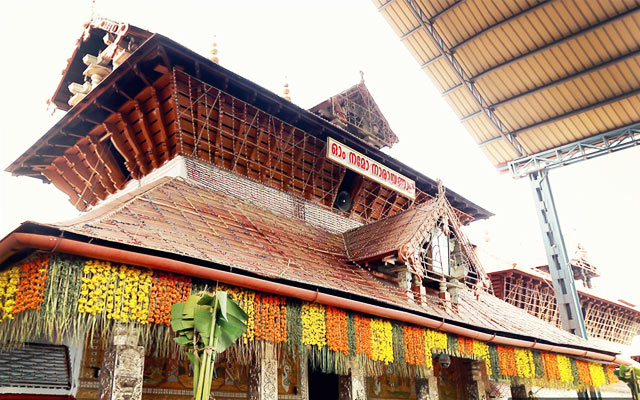Guruvayoor, the abode of Lord Sree Guruvayoorappan, is located 29 kms north west to the cultural capital of the 'God's own country', Kerala. This narrow coastline strip of land on the south western edge of Indian subcontinent is one of the 10 paradises in the world.
Guruvayoor is a thriving township in Trichur district of Kerala state in the South of India, its scenic beauty and serenity are breath taking. Guruvayoorappan is the chief diety here - The God which hears the prayers of its pilgrims. Guruvayoorappan is adorned with the holy tulasi (Basil) garland, and pearl necklace the Lord here appears in all radiance to bless the devotees.

In 1716 AD The Dutch plundered and set fire to the temple. It was rebuilt in 1747 AD.In 1766 AD Haider Ali captured Calicut and Guruvayoor, but spared the temple for a reason of 10000 Ferams which was paid by Vatakkepat Variyar.The general insecurity prevailing; the flow of pilgrims and the annual payment of tenants ceased. Haider Ali however gave a 'Devadaya' (free gift) to the temple in 1780 AD., on the recommendation of the Governer of Malabar, Srinivasa Rao and thus saved the temple from total extinction.
In 1789, Tipu Sultan, Haider Ali's son and successor descended on the scene to defeat the Zamorin and to convert Hindus to Islam. Fearing destruction of the image, the Mulavigraha (Main deity) was hidden underground and the Utsavavigraha (processional deity) was taken to Ambalapuzha. Tipu set fire to and plundered the temple. But a timely rain and an incorporeal voice averted a major catastrophe. After the English drove out Tipu, both the vigrahas (deities) were reinstalled. From 1875 to 1900, the Ullanad Panikars came in and offered their free secures to the lord apart from contributing from their family estates. [Like the earlier devotees Chempakasseri Nambudiri & Desavarma Nambudiri who had donated everything they had, to the lord].
In 1841, the Govt. of Madras restored the Devadaya appropriated by Tipu Sultan. Slowly & steadily the temple became prosperous. All the portions were rebuilt renovated and ornamented. At the turn of the 20th century various reforms have seen in the temple under the administration of its manager Sri Konti Menon. In 1928, the Zamorin once again became responsible for the administration of the temple.
In 1931-32, a Sathyagraha was launched under the leadership of Kerala Gandhi, i.e., Kelappan, a prominent group leader of Kerala, to secure the entry of untouchables in to the temple. All this resulted in the Travancore Temple Entry proclamation in 1936, and similar measures in British Malabar in 1946 & Cochin in 1947. Since then every Hindu is permitted to have a darshan of the Lord outside the sanctum sanctorum (Sree kovil). Yet the offering of Namaskara sadhya (feast) exclusively to Brahmins in the Uttupura (dining hall) continued. Finally this custom was also sapped. From 1st Jan 1982, the Devaswam itself feeds 500 – 1000 pilgrims, with Prasadam (Prasada Oottu). Devotees too can make an offering of any amount for free feeding.
On 30th November 1970, after the 6th day of the annual Ekadasi festival, a disastrous fire broke out in the temple Hindus, Muslims & Christians fought the fire shoulder to shoulder. Despite 5 hours of the raging fire, the Srikovil, the vigraha of Guruvayoorappan, and the subshrines of Ganesha, Ayyappa and Devi, and the flag staff remained intact.




